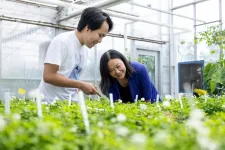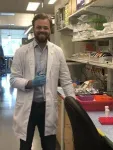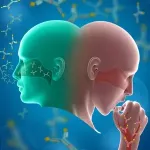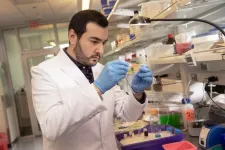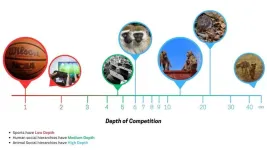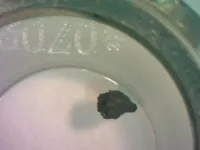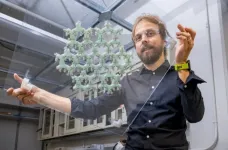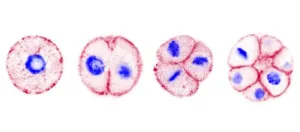(Press-News.org) Biologists at Washington University in St. Louis have discovered the origin of a curious duplication that gives plants multiple ways to override instructions that are coded into their DNA. This research could help scientists exploit a plant’s existing systems to favor traits that make it more resilient to environmental changes, like heat or drought stress.
The study led by Xuehua Zhong, a professor of biology in Arts & Sciences, was published Nov. 6 in Science Advances.
Zhong’s new research focuses on DNA methylation, a normal biological process in living cells wherein small chemical groups called methyl groups are added to DNA. This activity controls which genes are turned on and off, which in turn affects different traits — including how organisms respond to their environments.
Part of this job involves silencing, or turning off, certain snippets of DNA that move around within an organism’s genome. These so-called jumping genes, or transposons, can cause damage if not controlled. The entire process is regulated by enzymes, but mammals and plants have developed different enzymes to add methyl groups.
“Mammals only have two major enzymes that add methyl groups in one DNA context, but plants actually have multiple enzymes that do that in three DNA contexts,” said Zhong, who is the Dean’s Distinguished Professorial Scholar and program director for plant and microbial biosciences at WashU. “This is the focus of our study. The question is — why do plants need extra methylation enzymes?”
Looking forward, Zhong’s research could pave the way for innovations in agriculture by improving crop resilience. “Certain genes or combinations of genes are contributing to certain features or traits,” Zhong explained. “If we find precisely how they are regulated, then we can find a way to innovate our technology for crop improvement.”
Evolving differernt functions
The new study is centered around two enzymes specifically found in plants: CMT3 and CMT2. Both enzymes are responsible for adding methyl groups to DNA, but CMT3 specializes in the parts of DNA called the CHG sequences, while CMT2 specializes in different parts called CHH sequences. Despite their functional differences, both enzymes are a part of the same chromomethylase (CMT) family, which evolved through duplication events that provide plants with additional copies of genetic information.
Using a common model plant called Arabidopsis thaliana, or thale cress, Zhong and her team investigated how these duplicated enzymes evolved different functions over time. They discovered that somewhere along the evolutionary timeline, CMT2 lost its ability to methylate CHG sequences. This is because it’s missing an important amino acid called arginine.
“Arginine is special because it has charge,” said Jia Gwee, a graduate student in biology and co-first author of the study. “In a cell, it’s positively charged and thus can form hydrogen bonds or other chemical interactions with, for example, the negatively charged DNA.”
However, CMT2 has a different amino acid — valine. “Valine is not charged, so it is unable to recognize the CHG context like CMT3. That’s what we think contributes to the differences between the two enzymes,” said Gwee, winner of the Dean’s Award for Graduate Research Excellence in Arts & Sciences.
To confirm this evolutionary change, the Zhong lab used a mutation to switch arginine back into CMT2. As they expected, CMT2 was able to perform both CHG and CHH methylation. This suggests that CMT2 was originally a duplicate of CMT3, a backup system to help lighten the load as DNA became more complex: “But instead of simply copying the original function, it developed something new,” Zhong explained.
This research also provided insights about CMT2’s unique structure. The enzyme has a long, flexible N-terminal that controls its own protein stability. “This is one of the ways plants evolved for genome stability and to fight environmental stresses,” Zhong said. This feature may explain why CMT2 evolved in plants growing in such a wide variety of conditions worldwide.
Much of the data for this study came from the 1001 Genomes Project, which aims to discover whole-genome sequence variation in A. thaliana strains from around the globe.
“We’re going beyond laboratory conditions,” Zhong said. “We’re looking at all of the wild accessions in plants using this larger data set.” She believes part of the reason A. thaliana has evolved to thrive despite environmental stresses is because of the diversification that happens during the methylation process, including those jumping transposons: “One jump might help species deal with harsh environmental conditions.”
END
How plants evolved multiple ways to override genetic instructions
WashU biologists investigate inner workings of DNA methylation in plants
2024-11-06
ELSE PRESS RELEASES FROM THIS DATE:
Nasal swab tests predict COVID-19 disease severity, Emory study finds
2024-11-06
A wide variety of COVID-19 symptoms exist, ranging from mild to severe, and while current strains of the virus generally cause milder symptoms, those with co-morbidities are still at an exponentially greater risk of severe disease. Now, new research from Emory University is providing a more precise prediction of COVID-19 severity that can be found by looking at autoantibodies in the nasal cavity, leading to more personalized treatment plans. For high-risk individuals, this could provide critical information to inform immediate treatment options, including ...
'Shallow' sports and 'deep' social hierarchies: Not all pecking orders are created equal
2024-11-06
University of Michigan researchers have added a new dimension to the mathematics used to predict the outcomes of all manner of competitions, including sports, games and social hierarchies in both humans and animals.
This dimension, which they call "depth of competition," can be integrated into a variety of important and lucrative fields. It could, for instance, help project winners of match-ups in sports, forecast consumer preferences, rank universities and evaluate hiring practices.
But it also ...
New PFAs testing method created at UMass Amherst
2024-11-06
AMHERST, Mass. — University of Massachusetts Amherst researchers have discovered a new way to detect per- and polyfluoroalkyl substances (PFAS) in water. This marks an important step forward in creating testing devices that are simpler, more cost-effective, faster and generally more accessible than existing methods.
PFAS, the so-called forever chemicals, have been recognized as a concerning pollutant.
These chemicals persist in the environment because they resist breaking down and pose significant health threats. Exposure to these chemicals is linked to various cancers ...
Asteroid grains shed light on the outer solar system’s origins
2024-11-06
Tiny grains from a distant asteroid are revealing clues to the magnetic forces that shaped the far reaches of the solar system over 4.6 billion years ago.
Scientists at MIT and elsewhere have analyzed particles of the asteroid Ryugu, which were collected by the Japanese Aerospace Exploration Agency’s (JAXA) Hayabusa2 mission and brought back to Earth in 2020. Scientists believe Ryugu formed on the outskirts of the early solar system before migrating in toward the asteroid belt, eventually settling into an orbit between Earth and Mars.
The team analyzed Ryugu’s particles for signs of any ancient magnetic field that might have been present ...
Grant supports finding brain-inspired ways to develop low-energy computing
2024-11-06
The human brain is an astonishing organ, as any neuroscientist can attest. And its ability to collect, store, analyze and use information is intriguing to physicists, engineers and computer scientists, too.
Benjamin Jungfleisch, associate professor of physics at the University of Delaware, is among them.
Jungfleisch, who joined UD’s faculty in 2018, is an expert in magnon spintronics. He uses lasers to explore the dynamics of magnetic nanostructures — tiny magnets that can be used to ...
People engaging in self-harm find support on Reddit. But is that community helping them?
2024-11-06
A new study from the University of Georgia suggests people posting in Reddit’s r/selfharm community are likely seeking support for negative emotions.
While sharing traumatic events online can be cathartic, the researchers caution that subreddits can’t provide the same type of mental health help and support face-to-face interactions and professional help can.
“We don’t know the accuracy of the information that’s being shared in these communities about nonsuicidal self-injury,” ...
The egg or the chicken? An ancient unicellular says egg!
2024-11-06
Chromosphaera perkinsii is a single-celled species discovered in 2017 in marine sediments around Hawaii. The first signs of its presence on Earth have been dated at over a billion years, well before the appearance of the first animals. A team from the University of Geneva (UNIGE) has observed that this species forms multicellular structures that bear striking similarities to animal embryos. These observations suggest that the genetic programmes responsible for embryonic development were already present before the emergence of animal life, ...
Coping and resilience aids parents of disabled children, study says
2024-11-06
OXFORD, Miss. – For parents of children with disabilities, finding time to focus on themselves may be difficult. However, a new study finds that the right coping strategies and resilience can significantly help manage the challenges of raising children with special needs.
That is the key finding from research published in the International Journal of Developmental Disabilities that studied families with neurodevelopmentally disabled children in Ghana to see what helps parents cultivate healthy, happy lives for themselves and their children.
“Our main interest ...
Lupus Research Alliance announces inaugural recipients of Translational Bridge Award
2024-11-06
New York, NY. November 6, 2024. The Lupus Research Alliance (LRA) is excited to announce the first-ever recipients of the Translational Bridge Award (TBA), established this year to accelerate the translation of groundbreaking research into potential treatments and diagnostics for lupus. The award aims to propel high-potential projects from LRA-funded foundational discoveries with strong commercialization potential or an opportunity for clinical evaluation. Five exceptional researchers have been awarded the 2024 Translational Bridge Award to tackle pressing ...
Brain stars hold our memories
2024-11-06
A study published in Nature by researchers at Baylor College of Medicine changes the way we understand memory. Until now, memories have been explained by the activity of brain cells called neurons that respond to learning events and control memory recall. The Baylor team expanded this theory by showing that non-neuronal cell types in the brain called astrocytes – star-shaped cells – also store memories and work in concert with groups of neurons called engrams to regulate storage and retrieval of memories.
“The prevailing idea is that the formation and recall of memories only involves neuronal engrams that are activated by certain ...
LAST 30 PRESS RELEASES:
New microfluidics technology enables highly uniform DNA condensate formation
A new strategy for immune tolerance
Super Mario Bros. help fight burnout: New study links classic games to boosted happiness
Deepest gas hydrate cold seep ever discovered in the arctic: International research team unveils Freya Hydrate Mounds at 3,640 m depth.
Integrating light and structure: Smarter mapping for fragile wetland ecosystems
ACA-SIM: A robust way to decode satellite signals over complex waters
Probiotics can restore gut microbiome in breastfed infants
AI could help predict nutrition risks in ICU patients, study finds
Federal EITC has unexpected result, researchers say – it decreases domestic violence
Researchers identify gene that calms the mind and improves attention in mice
Artificial metabolism turns waste CO2 into useful chemicals
Ancient sea anemone sheds light on animal cell type evolution
Begging gene leads to drone food
How climate policies that incentivize and penalize can drive the clean energy transition
Can community awareness campaigns in low-resource areas improve early diagnosis of colorectal cancer?
Stardust study resets how life’s atoms spread through space
Practical education: Clinical scenario-based program development
The impact of family dynamics on eating behaviour – how going home for Christmas can change how you eat
Tracing the quick synthesis of an industrially important catalyst
New software sheds light on cancer’s hidden genetic networks
UT Health San Antonio awarded $3 million in CPRIT grants to bolster cancer research and prevention efforts in South Texas
Third symposium spotlights global challenge of new contaminants in China’s fight against pollution
From straw to soil harmony: International team reveals how biochar supercharges carbon-smart farming
Myeloma: How AI is redrawing the map of cancer care
Manhattan E. Charurat, Ph.D., MHS invested as the Homer and Martha Gudelsky Distinguished Professor in Medicine at the University of Maryland School of Medicine
Insilico Medicine’s Pharma.AI Q4 Winter Launch Recap: Revolutionizing drug discovery with cutting-edge AI innovations, accelerating the path to pharmaceutical superintelligence
Nanoplastics have diet-dependent impacts on digestive system health
Brain neuron death occurs throughout life and increases with age, a natural human protein drug may halt neuron death in Alzheimer’s disease
SPIE and CLP announce the recipients of the 2025 Advanced Photonics Young Innovator Award
Lessons from the Caldor Fire’s Christmas Valley ‘Miracle’
[Press-News.org] How plants evolved multiple ways to override genetic instructionsWashU biologists investigate inner workings of DNA methylation in plants
